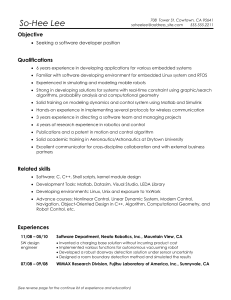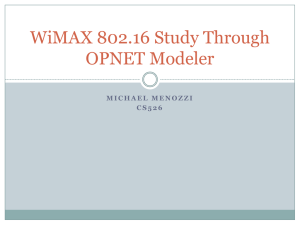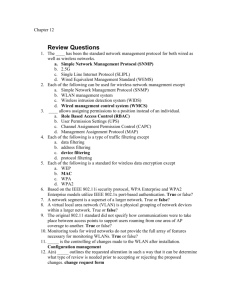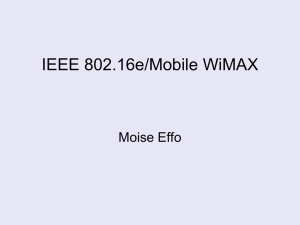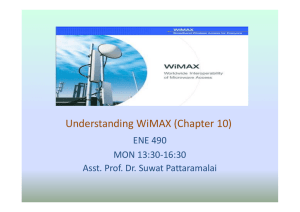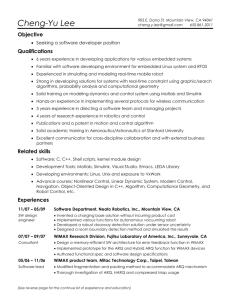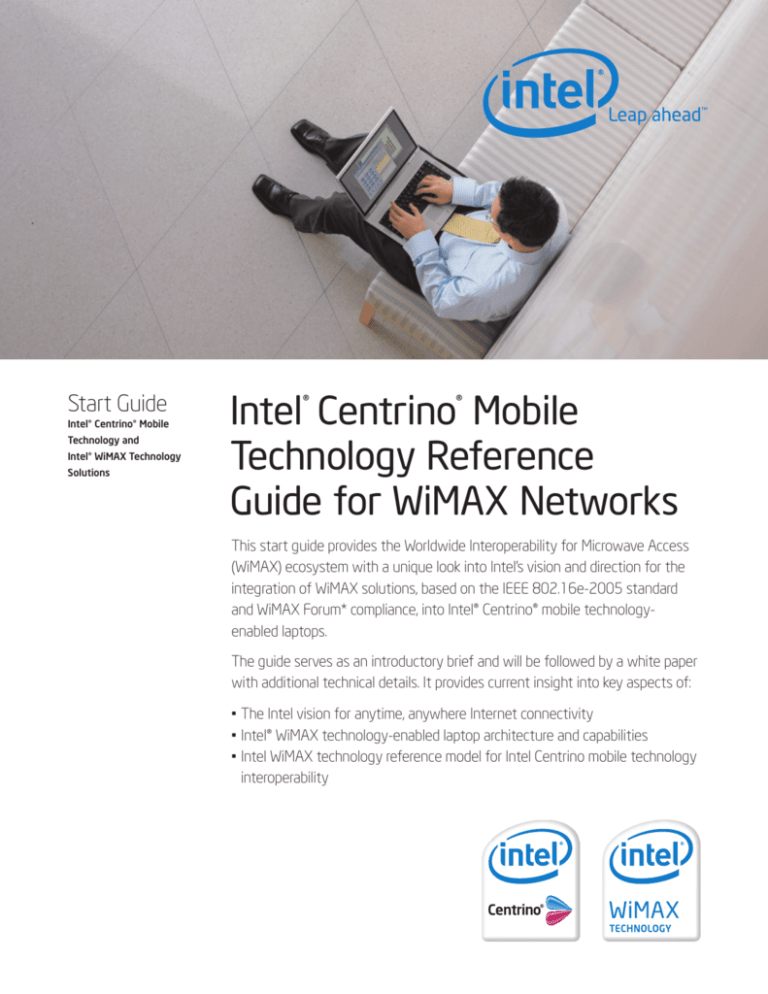
Start Guide
Intel® Centrino® Mobile
Technology and
Intel® WiMAX Technology
Solutions
Intel® Centrino® Mobile
Technology Reference
Guide for WiMAX Networks
This start guide provides the Worldwide Interoperability for Microwave Access
(WiMAX) ecosystem with a unique look into Intel's vision and direction for the
integration of WiMAX solutions, based on the IEEE 802.16e-2005 standard
and WiMAX Forum* compliance, into Intel® Centrino® mobile technologyenabled laptops.
The guide serves as an introductory brief and will be followed by a white paper
with additional technical details. It provides current insight into key aspects of:
• The Intel vision for anytime, anywhere Internet connectivity
• Intel® WiMAX technology-enabled laptop architecture and capabilities
• Intel WiMAX technology reference model for Intel Centrino mobile technology
interoperability
Introduction
WiMAX is a key component of Intel's broadband
wireless strategy to deliver innovative mobile
platforms for anytime, anywhere Internet
connectivity. New and emerging multimedia
applications and broadband remote access are
driving the need for very high-speed wide area
Internet access to mobile devices. WiMAX is an
advanced technology solution, based on the
IEEE 802.16-2005 standard, designed to meet
this need, and to do so in a low-cost, flexible way.
WiMAX networks are optimized for high-speed
data and are expected to spur innovation in
services, content, and new mobile devices.
Start Guide Intel® Centrino® Mobile Technology Reference Guide for WiMAX Networks
WiMAX Ecosystem
The WiMAX ecosystem has made great progress in the
development and deployment of WiMAX solutions, and
momentum is increasing with:
• Ratification of IEEE 802.16e-2005 in December 2005.
• Real WiMAX deployments around the globe: 175 today
and growing.
• A strong and rapidly growing WiMAX ecosystem that is
expected to offer choice and lower costs to consumers:
The WiMAX Forum currently counts over 370 member
companies.
• Consensus on 2.3 GHz, 2.5 GHz, and 3.5 GHz spectrum
bands for WiMAX network deployment.
In order to accelerate WiMAX deployment and adoption,
ecosystem alignment around an end-to-end system
implementation is critical. With such alignment, we expect
interoperability, economies of scale, and optimized system
costs and performance.
Intel® Centrino® Mobile Technology
Reference Guide
This guide is intended to help achieve ecosystem alignment
by giving service providers and the WiMAX industry ecosystem
a view into Intel's currently planned future mobile platforms. It
includes an overview of usage models and laptop platform
capabilities, a description of the relationship between platform
capabilities and key elements of the mobile WiMAX network,
and most importantly, a reference model for service providers
and the ecosystem based on Intel's planned mobile platform
capabilities.
The “Intel Centrino Mobile Technology Reference Guide for
WiMAX Networks” provides a unique look at what is required
to support consistent access to WiMAX networks by clients
coming from and moving to any network. Intel's goal is to
establish a common standards-based approach to promote
interoperability.
The audience and intended usage for this guide is:
• WiMAX operators and service providers. To plan new
network deployments and upgrade existing networks, and in
so doing, helping to ensure networks are Intel Centrino mobile
technology-ready to provide easy access, security features,
and advanced functionality to their WiMAX users.
• WiMAX equipment vendors. To develop infrastructure
solutions interoperable with WiMAX-enabled Intel Centrino
mobile technology-enabled laptops.
• Application and service developers. To develop
innovative applications and services using the features
and capabilities supported in WiMAX-enabled Intel Centrino
mobile technology-enabled laptops.
The ultimate goal is for the WiMAX industry to join together
to promote the adoption of open, Internet Protocol (IP) based
standards for authentication, authorization, accounting, Quality
of Service (QoS), security, mobility/roaming, and low-power
operation to help enable consistent, reliable network performance for access devices such as laptops, ultra-mobile PCs,
and more.
3
Start Guide Intel® Centrino® Mobile Technology Reference Guide for WiMAX Networks
Anytime, Anywhere
Connectivity
PR
Anytime, Anywhere Connectivity
AN
AM
D
LE
TE
SS
EC
D
SI
MP
LE
Connect Me. Easy, protected, and cost-effective connections
between people, devices, and services.
OT
Intel's current vision for anytime, anywhere connectivity is to
enable protected, simple, and seamless access to the Internet.
WiMAX is a key component of Intel's current vision, enabling
laptops with high-performance, cost-effective, and ubiquitous
wireless access to the Internet.
With anytime, anywhere usage, laptops will be capable of
establishing basic connections, as well as supporting seamless
connectivity and accessibility across technologies. See Figures
1 and 2.
Reach
Me
Connect
Me
SE
WiMAX-enabled Laptops
Keep Me
Connected
Figure 1. Anytime, Anywhere Connectivity
Creating usage models that enable protected, simple, and seamless
access to the Internet is the core of Intel's laptop connectivity vision.
Keep Me Connected. Seamless security features and
connectivity while on-the-go.
Reach Me. Easily reachable while on-the-go, based on user
preference.
Any
Network
Future
UWB
WiMAX
WWAN
WLAN
Today
Secure
One Bill
Seamless
Always
Reachable
Figure 2. Anytime, Anywhere Connectivity Evolution
Future laptops are expected to integrate multiple communications
technologies (vertical axis), as well as communication stacks, enabling
protected, simple, and seamless access to the Internet (horizontal axis).
4
Start Guide Intel® Centrino® Mobile Technology Reference Guide for WiMAX Networks
Intel Centrino Mobile Technology for Laptops
Intel Centrino mobile technology for laptops consists of Intel®
component and software solutions, integrated by Intel to
achieve optimal cost and performance. Key components of
Intel Centrino mobile technology include Intel® processor,
chipset, and network adapter solutions. Figure 3 illustrates
this integration.
Laptop Communications Architecture
Laptops supporting anytime, anywhere connectivity will
integrate multiple wireless technologies, along with
communications software solutions, helping to make the
connectivity experience protected, simple, and seamless
from the user perspective.
Hardware. Integrated smart card and wireless PAN/LAN/WAN
technologies to provide economical, ubiquitous connectivity.
Network drivers/stacks. Hardware drivers and network stacks,
for example TCP/IP and Client Mobile IP (CMIP), providing
optimal performance for supported wireless technologies.
Processor
Chipset
Network
Adapter
Functional engines/clients. Capabilities that can be used by
services and applications through open application programmatic interfaces (APIs).
Connection and policy management. Simple user
management of connections and connectivity preferences.
Aware applications. Applications using integrated engine/client
capabilities to provide a rich connectivity experience.
IMS
Location
Aware
Figure 3. Intel® Centrino® Mobile Technology
Network adapter solutions consist of mini-card modules that plug into
slots on the laptop motherboard, and interface with the host processor
via the chipset. Future network adapter solutions are planned to
integrate WiMAX and Wi-Fi* onto a single mini-card module.
Smart Card
Aware
Applications
Connectivity Policy
Management Engine
Roaming
Aware
Connection Manager
Application Presentation Interfaces
Roaming
Engine
Security
Supplicant
Location
Engine
Device
Management
Client
IMS
Client
Networking Stack
Networking Drivers
BT
UWB
Wi-Fi*
WWAN
WiMAX
Smart Card
Figure 4. Laptop Communications Architecture
Communication hardware and software components of future laptops.
5
Start Guide Intel® Centrino® Mobile Technology Reference Guide for WiMAX Networks
Guide Overview
This section provides a brief overview of some of the topics to
be addressed in the detailed technical white paper expected
to be published later this year. The intention of this guide is to
provide some early information to help ensure WiMAX network
interoperability with WiMAX-enabled Intel Centrino mobile
technology-enabled laptops.
Intel fully supports the WiMAX Forum and has taken a leadership position in its promotion and development. In developing
the “Intel Centrino Mobile Technology Reference Guide for
WiMAX Networks,” Intel paid special attention to developing
reference models that conform to the work the WiMAX Forum's
Technical, Certification, and Network Working Groups are doing,
based on requirements defined by the Service Provider Working
Group, specifically:
• Specifications for infrastructure and client interoperability
• Specifications and process for client and base station
certification
• Specifications for end-to-end network architecture and
protocols
In this manner, Intel is supporting the broad WiMAX industry
defined system profiles, network specifications, and conformance test specifications.
End-to-End Reference Model for Intel Centrino Mobile
Technology Interoperability
The reference model for Intel Centrino mobile technology interoperability is based on the laptop communications architecture
discussed in the previous section, combined with the WiMAX
network reference model developed within the WiMAX Forum.
Relationships and interoperability requirements between
functional entities will be specified in the forthcoming white
paper version of this guide.
R2
ASN
IMS
Location
Aware
Smart Card
Aware
Applications
Connectivity Policy
Management Engine
Roaming
Aware
Connection Manager
MS
R1
BS
R8
Application Presentation Interfaces
Roaming
Engine
Security
Supplicant
Location
Engine
Device
Management
Client
IMS
Client
BS
ASN
Networking Drivers
UWB
Wi-Fi*
WWAN
R6
WiMAX
Smart Card
NAP
AAA
ASN GW
R4
R4
Networking Stack
BT
CSN
R6
ASN GW
R3
HA
DNS
IMS
DHCP
NSP
Internet
R5
CSN
NOTE: NWG specification defines three interoperable ASN profiles.
Figure 5. Reference Model for Intel® Centrino® Mobile Technology Interoperability
The reference model is based on the relationship between key functional elements of the laptop communications architecture (left) and WiMAX network
architecture (right). For network elements in the ASN where a subset of functionality relates to MS interoperability, these functions are mapped to ASN profiles
as specified in the NWG specification.
6
Start Guide Intel® Centrino® Mobile Technology Reference Guide for WiMAX Networks
Reference Model Key Terminology
and Definitions
AAA
ASN
authentication, authorization, and accounting
access service network
ASN GW access service network gateway
BS
base station
FA
foreign agent
CSN
HA
IMS
MS
NAP
NSP
R1
R2
R3
R4
R5
R6
R8
connectivity service network
home agent
IP multimedia subsystem
mobile station
network access provider
A business entity that provides WiMAX radio access
infrastructure to one or more WiMAX NSPs. NAPs
implement this infrastructure using one or more ASNs.
network service provider
A business entity that provides IP connectivity and
WiMAX services to subscribers, compliant with the
service level agreement it establishes with them.
Protocols and procedures between MSs and ASNs
per the IEEE 802.16 specifications, plus IP layer
and above protocols that determine end-to-end
interoperability.
Protocols and procedures between the MS and CSN
associated with features such as authentication,
services authorization, IP host configuration
management, and tunneling between the MS and
the CSN.
Protocols between the ASN and the CSN 1 to support
features such as AAA, policy enforcement, and mobility
management.
Protocols and procedures originating and terminating in
various functional entities of an ASN that coordinate MS
mobility between ASNs.
Protocols for roaming between the CSN operated by a
home NSP and that operated by a visited NSP.
System Profile
The WiMAX Forum mobile system profile defines the required
and optional air interface (physical and medium access layers)
features supported for interoperability between the WiMAX BS
and MS equipment, based on the IEEE 802.16e-2005 and ETSI
HiperMAN standards needed for compliance to WiMAX Forum
certification. WiMAX-enabled Intel Centrino mobile technologyenabled laptops as currently planned will comply with all
WiMAX Forum mobile requirements.
During vendor development and self-test, Intel plans to prioritize interoperability testing with BS solutions supporting MIMO
and AAS/BF due primarily to the improved coverage, capacity,
and user throughput performance of systems supporting these
technologies.
Ethernet CS (defined as an optional feature for WiMAX BS
and MS equipment in the system profile) support is expected
primarily in CPE/RG solutions targeted for fixed service offerings. While WiMAX-enabled Intel Centrino mobile technologyenabled laptops will co-exist on a BS supporting Ethernet CS.
Release 1
System Profile
BS
MS
Intel® Centrino®
Mobile
Technology
Support
Baseline
PHY/MAC
Mandatory
Mandatory
Yes
MIMO
Optional
Mandatory
Yes
AAS/BF
Optional
Mandatory
Yes
MBS
Optional
Mandatory
Yes
Table 1. Intel® Centrino® Mobile Technology System Profile Support
WiMAX-enabled Intel® Centrino® mobile technology-based laptops will
support the features required for mobile stations as defined in the WiMAX
Forum system profile.
Protocols and procedures for communication between
the BS and the ASN GW (if applicable in an ASN profile).
The bearer plane consists of features such as intra-ASN
data path between the BS and ASN gateway. The
control plane includes features such as data path
establishment, modification, and release control in
accordance with the MS mobility events.
Optional control plane message flows and bearer plane
data flows directly between neighbor base stations
(if applicable in an ASN profile) to support fast and
seamless handovers.
7
Start Guide Intel® Centrino® Mobile Technology Reference Guide for WiMAX Networks
Certification Profiles
The certification profiles define the frequency band, duplexing
scheme, and channel bandwidth supported for interoperability
of WiMAX BS and MS equipment. Of the candidate WiMAX
Forum mobile certification profiles, WiMAX-enabled Intel
Centrino mobile technology-enabled laptops targeting
regional/global roaming are planned to prioritize support for
certification profiles based on the 5 MHz, 8.75 MHz (required
for South Korea), and 10 MHz channel bandwidths.
Access Service Network Functionality
The ASN represents the point of entry for WiMAX MS equipment into a WiMAX network, and as such, must support a
complete set of network functions required to provide radio
access to the MS. The ASN provides the following mandatory
functions:
• WiMAX Layer-2 (L2) connectivity with WiMAX MS
• Transfer of AAA messages to the WiMAX subscriber’s home
network service provider (H-NSP) for authentication, authorization and session accounting for subscriber sessions
• Network discovery and selection of an appropriate NSP from
which the subscriber accesses WiMAX services
In addition to the previous mandatory functions, for a portable
and mobile environment, an ASN shall support the following
functions:
• ASN anchored mobility
• CSN anchored mobility
• Paging and location management
The ASN is comprised of network elements such as one or
more base stations, and one or more ASN gateways, and
may be shared by more than one connectivity service
network (CSN).
Handover
The WiMAX Forum Networking Working Group (NWG) WiMAX
network specifications identify the following types of mobility
within a WiMAX Network:
• ASN anchored mobility. Mobility of MS between two BSs
(serving and target BS) within or across an ASN boundary.
• CSN anchored mobility. Mobility resulting in change of
point of attachment IP address for the MS when anchored to
the same CSN.
• Relay functionality for establishing Layer-3 (L3) connectivity
with a WiMAX MS (for example, IP address allocation)
• Radio resource management
• ASN-CSN tunneling
1
2
3
4
5
Frequency
Range [GHz]
2.3-2.4
2.305-2.320
2.345-2.360
2.496-2.690
3.3-3.4
3.4-3.8
Duplex
TDD
TDD
TDD
TDD
TDD
5
1.B
2.B
3.A
4.A
5.A
8.75
1.A
10
1.B
2.C
3.A
4.C
5.C
Channel
Bandwidth [MHz]
Band Class
8
Table 2. Intel® Centrino®
Mobile Technology Certification
Profile Support
Selected Certification Profiles to
be supported in WiMAX-enabled Intel®
Centrino® mobile technology-enabled
laptops.
Start Guide Intel® Centrino® Mobile Technology Reference Guide for WiMAX Networks
R2
ASN
IMS
Location
Aware
Connectivity Policy
Management Engine
Smart Card
Aware
Applications
Roaming
Aware
Connection Manager
MS
R1
BS
Roaming
Engine
Security
Supplicant
Location
Engine
IMS
Client
BS
R6
Paging
Control/Agent
R3
AAA
HA
AAA
PMIP Client
MIP FA
Authenticator
AAA Client
R8
Application Presentation Interfaces
Device
Management
Client
R6
3GPP2
CSN
ASN GW
IMS
I-CSCF
HSS
ASN
Networking Drivers
Wi-Fi*
WWAN
AAA
P-CSCF S-CSCF
WAG
PDG
Wi-Fi
ASN GW
AAA
R5
CSN
UWB
3GPP2
R4
Networking Stack
BT
FA/HA
WiMAX
FA/HA
Smart Card
Figure 6. ASN Functionality
Reference model for Intel® Centrino® mobile technology interoperability highlighting some of the elements related to handover and power management.
The procedures related to CSN anchored mobility are dependent on whether network access is based on IPv4 or IPv6. In
the case of IPv4, handover can be performed based on Proxy
Mobile IP (PMIPv4) or Client Mobile IP (CMIPv4). The PMIPv4
procedure is entirely done in the network and the MS is
agnostic to the related procedures. For IPv6, CSN anchored
mobility is performed based on CMIPv6.
Service Provisioning, Authentication,
and Security
Power Management
In a WiMAX network, a full network discovery and selection
procedure includes four steps:
Power management for MS equipment is vital to helping
ensure optimal battery life performance. Platform power management refers to the efficient allocation of sleep and idle
modes to an MS in order to help maximize battery life while
minimizing disruption of communication flows between an MS
and the WiMAX network.
Idle mode capabilities defined within the IEEE 802.16e-2005
standard allow for MS equipment to power down in order to
optimize battery life. Paging refers to procedures used by the
WiMAX network to seek an MS in idle mode within the coverage area of a predefined BS or set of BSs (identified by a
paging group). Coordination of paging procedures is handled by
the paging control/agent functions residing in the ASN GW.
Paging in WiMAX networks can be based on either unicast or
multicast addressing. WiMAX-enabled Intel Centrino mobile
technology will support unicast paging.
In order for a WiMAX MS to securely enter a WiMAX network,
robust schemes and protocols for various network entry
scenarios must be supported, as well as strong protection
of user data traffic and control messaging.
Service Provisioning
1. NAP discovery
2. NSP access discovery
3. NSP enumeration and selection
4. ASN attachment based on NSP selection
The procedure is applicable to the first time use, initial network
entry, network re-entry, or when an MS transitions across NAP
coverage areas.
In the case of first time use, the authenticity of the MS must
be established in order to allow for provisioning of service and
access to Internet services. WiMAX-enabled Intel Centrino
mobile technology-enabled laptops are expected to support
either over-the-air (OTA) or smart-card-based service
provisioning.
9
Start Guide Intel® Centrino® Mobile Technology Reference Guide for WiMAX Networks
R2
ASN
IMS
Location
Aware
Smart Card
Aware
Applications
Connectivity Policy
Management Engine
Roaming
Aware
Connection Manager
R1
MS
BS
Roaming
Engine
Security
Supplicant
Location
Engine
Device
Management
Client
BS
IMS
Client
Wi-Fi*
WWAN
DNS
IMS
ASN GW
DHCP
NSP
ASN
Networking Drivers
UWB
R6
R3
R4
Networking Stack
BT
R4
WiMAX
Internet
R5
CSN
NAP
Smart Card
HA
AAA
Authenticator
R8
Application Presentation Interfaces
CSN
ASN GW
R6
NOTE: NWG specification defines three interoperable ASN profiles.
Figure 7. Service Provisioning
Reference model for Intel® Centrino® mobile technology interoperability highlighting key elements related to MS authentication by a WiMAX network.
In the case of OTA provisioning, credentials (for example X.509
certificates) indicating that the WiMAX Forum has certified
the MS will be stored in the MS during manufacturing.
PKMv2/EAP-TLS is being considered for establishing
credentials during service provisioning.
USIM-based service provisioning is expected to be supported
on UICC/smart-card-enabled laptops, utilizing PKMv2/EAP-AKA
as the mechanism for authentication.
Authentication
Once service has been provisioned, authentication is performed
on initial network entry, network re-entry, or transitions across
NAP coverage areas. Authentication may be based either on
user, or on both user and device. Double EAP authentication
will be supported for user and device authentication.
Non-smart-card-based authentication will utilize PKMv2/
EAP-TTLS (username/password) as the preferred mechanism
for user authentication, and may utilize PKMv2/EAP-TLS
(certificate) as the mechanism for device authentication.
R2
ASN
IMS
Location
Aware
Connectivity Policy
Management Engine
Smart Card
Aware
Applications
Roaming
Aware
Connection Manager
MS
R1
BS
R8
Application Presentation Interfaces
Roaming
Engine
Security
Supplicant
Location
Engine
Device
Management
Client
IMS
Client
BS
R4
ASN
Networking Drivers
UWB
Wi-Fi*
WWAN
R4
R6
WiMAX
Smart Card
ASN GW
R3
AAA
HA
AAA
Authenticator
DNS
3GPP2
AAA
DHCP
NAP
PDG
NSP
Wi-Fi
R5
CSN
NOTE: NWG specification defines three interoperable ASN profiles.
Figure 8. Roaming
Reference model for Intel® Centrino® mobile technology interoperability highlighting elements related to service provisioning and roaming.
10
FA/HA
WAG
Networking Stack
BT
R6
3GPP2
CSN
ASN GW
AAA
FA/HA
Start Guide Intel® Centrino® Mobile Technology Reference Guide for WiMAX Networks
Smart-card-based authentication is expected to utilize
PKMv2/EAP-AKA (user and device credentials stored in
smart card).
Security
Provisions for helping to ensure the integrity of user data traffic and control messaging is essential for wide scale system
deployment. Security and cryptographic suite support specified
in the WiMAX Forum Mobile System Profile represents the
latest in state of the art security.
Encryption of user data traffic is expected to be based on AES
in CCM mode. Management message integrity protection is
expected to be based on cipher-based MAC (CMAC).
Roaming
In order for innovative applications and services to be developed which utilize the functions and capabilities of the laptop,
open application presentation interfaces need to be defined as
part of the guide, enabling developers to create solutions that
provide users with a rich mobile Internet experience. Key areas
to be addressed include:
• QoS. User control of bandwidth/latency across multiple,
simultaneous applications via policy management.
• Location. Network- or platform-based location information.
• IMS. Integrated client on laptop.
• Device management. Remote configuration, monitoring,
performance, and capability enhancement.
IMS
Application Presentation Interfaces
Roaming
Engine
Security
Supplicant
Location
Engine
Device
Management
Client
IMS
Client
Networking Stack
AAA
AAA refers to a framework, based on IETF protocols (RADIUS
or Diameter), that specifies the protocols and procedures for
authentication, authorization, and accounting associated with
the user, MS device, and subscribed services. WiMAX networks
based on this framework and alignment around recommended
authentication schemes (EAP-AKA, EAP-TTLS, EAP-TLS) will
enable:
Location
Aware
Applications
Connectivity Policy
Management Engine
Smart Card
Aware
Connection Manager
Roaming
Aware
Roaming is the capability enabling a wireless subscriber to
obtain network services using a “visited” operator’s network
using credentials provided by the subscriber’s home operator. At
the most basic level, roaming typically requires the ability to reuse authentication credentials provided and provisioned by the
home operator in visited networks, successful user and device
authentication by the home operator, a mechanism for billing
reconciliation, and, optionally, access to services available over
the Internet.
Services/Applications
Networking Drivers
BT
UWB
Wi-Fi*
WWAN
WiMAX
Smart Card
Figure 9. Services and Applications
Laptop Communications Architecture highlighting key elements related to
advanced services and applications.
• Protected authentication, with roaming across WiMAX
networks, as well as inter-technology roaming
• Simplified “one bill” accounting
Smart Card Re-use
Smart card technology will become a key component of laptop
communication functions. The latest smart card standard, USIM,
supports multiple service credentials on a single smart card
(UICC). Smart card re-use on laptops is under investigation
for support of seamless authentication while roaming across
technologies (WiMAX, Wi-Fi, 3GPP, and 3GPP2 networks).
11
For more information
To learn more about Intel Corporation, visit www.intel.com.
IEEE Standard 802.16-2004, IEEE Standard for Local and Metropolitan Area Networks - Part 16: Air Interface for Fixed Wireless
Access Systems.
IEEE Std 802.16e™-2005, IEEE Standard for Local and metropolitan area networks Part 16: Air Interface for Fixed and Mobile
Broadband Wireless Access Systems, Amendment 2: Physical and Medium Access Control Layers for Combined Fixed and Mobile
Operation in Licensed Bands And Corrigendum 1.
WiMAX Forum Mobile Certification Profile v1.0.0, WiMAX Forum Certification Working Group, March 2006
WiMAX Forum Mobile System Profile v1.0.0, WiMAX Forum Technical Working Group, May 2006
This paper is for informational purposes only. THIS DOCUMENT IS PROVIDED "AS IS" WITH NO WARRANTIES WHATSOEVER, INCLUDING ANY
WARRANTY OF MERCHANTABILITY, NONINFRINGEMENT, FITNESS FOR ANY PARTICULAR PURPOSE, OR ANY WARRANTY OTHERWISE ARISING
OUT OF ANY PROPOSAL, SPECIFICATION OR SAMPLE. Intel disclaims all liability, including liability for infringement of any proprietary rights,
relating to use of information in this specification. No license, express or implied, by estoppel or otherwise, to any intellectual property rights
is granted herein.
Intel, the Intel logo, Intel. Leap ahead. and Intel. Leap ahead. logo, the Centrino logo, and Centrino are trademarks or registered trademarks of
Intel Corporation or its subsidiaries in the United States and other countries.
*WiMAX Forum™ is a registered certification mark of the WiMAX Forum. Other names and brands may be claimed as the property of others.
Copyright
©
2006 Intel Corporation. All rights reserved.
Printed in USA/0606/SS/PMS/PP/2K
Order Number: 313900-001US

